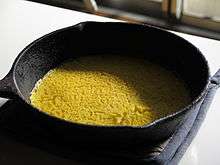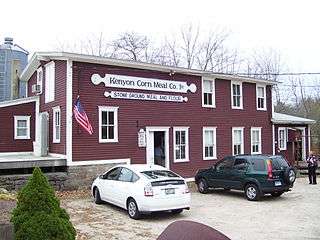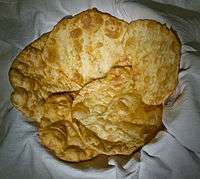Johnnycake
 A Johnnycake in a cast iron fry pan | |
| Alternative names | Jonnycake, shawnee cake, hoecake, johnny cake, journey cake, and johnny bread |
|---|---|
| Place of origin | United States |
| Main ingredients | Cornmeal |
|
| |
Johnnycake (also called journey cake, shawnee cake or johnny bread) is a cornmeal flatbread. An early American staple food, it is prepared on the Atlantic coast from Newfoundland to Jamaica.[1] The food originates from the native inhabitants of North America. It is still eaten in the West Indies, Dominican Republic, Saint Croix, Bahamas, Colombia, and Bermuda[2] as well as in the United States and Canada.
The modern johnnycake is found in the cuisine of New England,[3] and often claimed as originating in Rhode Island.[4] A modern johnnycake is fried cornmeal gruel, which is made from yellow or white cornmeal mixed with salt and hot water or milk, and sometimes sweetened. In the Southern United States, the word used is hoecake, although this can also refer to cornbread fried in a pan.
Etymology

Johnnycake
The earliest attestation of the term "johnny cake" is from 1739 (in South Carolina); the spelling "journey cake" is only attested from 1775 (on the Gulf coast), but may be the earlier form.[6][7]
The word is likely based on the word "Jonakin," recorded in New England in 1765, itself derived from the word "jannock," recorded in Northern England in the sixteenth century.[8] According to Edward Ellis Morris, the term was the name given "...by the [American] negroes to a cake made of Indian corn (maize)."[9]
Another suggested derivation is that it comes from Shawnee cake although some writers disagree.[10][11]
Hoecake
According to the Oxford English Dictionary, the term hoecake first occurs in 1745, and the term is used by American writers such as Joel Barlow and Washington Irving.[12] The origin of the name is the method of preparation: they were cooked on a type of iron pan called a hoe. There is conflicting evidence regarding the common belief that they were cooked on the blades of gardening hoes.[13] A hoecake can be made either out of cornbread batter or leftover biscuit dough. A cornbread hoecake is thicker than a cornbread pancake.[14]
Origin
Native Americans were using ground corn for cooking long before European explorers arrived in the New World. The johnnycake originates with the native inhabitants of Northern America; the Algonquians of the Atlantic seaboard are credited with teaching Europeans how to make the food.[15]
Southern Native American culture (Cherokee, Chickasaw, Choctaw, Creek) is the cornerstone of Southern cuisine. From this culture came one of the main staples of the Southern diet: corn (maize).[16] Corn was used to make all kinds of dishes from the familiar cornbread and grits to liquors such as whiskey and moonshine, which were important trade items. Cornbread was popular during the American Civil War because it was very cheap and could be made in many different sizes and forms. It could be fashioned into high-rising, fluffy loaves or simply fried for a fast meal.
To a far greater degree than anyone realizes, several of the most important food dishes that the Southeastern Indians live on today is the "soul food" eaten by both black and white Southerners. Hominy, for example, is still eaten ... Sofkee live on as grits ... cornbread [is] used by Southern cooks ... Indian fritters ... variously known as "hoe cake", ... or "Johnny cake." ... Indian boiled cornbread is present in Southern cuisine as "corn meal dumplings", ... and as "hush puppies", ... Southerners cook their beans and field peas by boiling them, as did the Indians ... like the Indians they cure their meat and smoke it over hickory coals.[17]
Preparation

Johnnycakes are an unleavened cornbread made of cornmeal (but see the Australian version below), salt, and water. Early cooks set thick corn dough on a wooden board or barrel stave, which they leaned on a piece of wood or a rock in front of an open fire to bake.[18] Hoecake was traditionally cooked on a hoe: "Hoe-Cake: A cake of Indian meal, baked before the fire. In the interior parts of the country, where kitchen utensils do not abound, they are baked on a hoe; hence the name."[19]
In the American south during the 18th century versions were made with rice or hominy flour and perhaps cassava.[20] A 1905 cookbook includes a recipe for "Alabama Johnny Cake" made with rice and 'meal'.[21]
The difference between johnnycake and hoecake originally lay in the method of preparation, though today both are often cooked on a griddle or in a skillet. Some recipes call for baking johnnycakes in an oven,[22] similar to corn pones, which are still baked in the oven as they were traditionally.[23]
Johnnycakes may also be made using leavening, with or without other ingredients more commonly associated with American pancakes, such as eggs or solid fats like butter. Like pancakes, they are often served with maple syrup, honey, or other sweet toppings.[3]
According to the manuscript of America Eats, a WPA guide to American food culture in the beginning decades of the twentieth century, Rhode Island "jonny cakes" were made in the 1930s as follows:
In preparation, [white corn] meal may or may not be scalded with hot water or hot milk in accordance to preference. After mixing meal with water or milk it is dropped on a smoking hot spider [pan] set atop a stove into cakes about 3"x3"x1/2" in size. The secret of cooking jonny cakes is to watch them closely and keep them supplied with enough sausage or bacon fat so they will become crisp, and not burn. Cook slowly for half an hour, turn occasionally, and when done serve with plenty of butter.[24]
Variations
Australia
In Australia, the word "Johnnycake" refers to a quick bread made with flour rather than cornmeal; the cakes are baked in the hot ashes of a fire or fried in fat in a skillet.[9]
Dominican Republic

Yaniqueques or yanikeke are a Dominican Republic version of the jonnycake, supposedly brought over in the 19th century by the Cocolos, or English-speaking migrants (possibly of Afro-Caribbean descent). These cakes are made with flour, baking powder, butter and water; however, they are typically deep-fried.[25][26] They are a popular beach snack, especially in Boca Chica.[27][28]
Puerto Rico
Both flour and cornmeal johnny cakes are popular beach food in Puerto Rico. They came to Puerto Rico from all over different parts of the Caribbean, notably of Dominican and Jamaican descent. They are deep-fried as most johnny cakes are and stuffed with seafood or as a sweet snack similar to funnel cake sprinkled with sugar and cinnamon. The recipe is similar to that found in other regions; flour or cornmeal with butter and baking soda are standard, but sometimes coconut milk is used instead of water.
United States
The modern jonnycake is a staple in the cuisine of New England[3] and New Englanders claim it originated in Rhode Island.[29] A modern jonnycake is fried gruel made from yellow or white cornmeal that is mixed with salt and hot water or milk, and sometimes sweetened. In the Southern United States, the same food is referred to as hoecake.
Jamaica
Johnnycake is a traditional staple across the island.[30] Some people call these fried dumplings whilst others say fried Johnnycakes. Recipe incorporates flour, sugar, salt, baking powder, margarine or butter and water or milk. Once kneaded, the dough is fried in cooking oil.
See also
References
- ↑ Kurlansky, Mark (2009). The food of a younger land: a portrait of American food; Before the national highway system, before chain restaurants, and before frozen food, when the nation's food was seasonal, regional, and traditional: from the lost WPA files. Penguin. p. 86. ISBN 9781594488658.
- ↑ Porter, Darwin; Danforth Prince (2009). Frommer's Bermuda 2010. Frommer's. p. 41. ISBN 9780470470626. Retrieved 14 March 2010.
- 1 2 3 New England Country Store Cookbook by Peter W. Smith (iUniverse 2003)
- ↑ Kurlansky, Mark (2009). The food of a younger land: a portrait of American food, before the national highway system, before chain restaurants, and before frozen food, when the nation's food was seasonal, regional, and traditional: From the lost WPA files. Penguin. p. 86. ISBN 9781594488658. Retrieved 14 March 2010.
- ↑ Meehan, Mary Beth (2 August 2006). "Jonnycakes from the Kenyon Corn Meal Company". Boston Globe. Retrieved 2008-11-06.
- ↑ "Johnny-cake". Oxford English Dictionary. 1989.
- ↑ Harper, Douglas. "johnny-cake". Online Etymology Dictionary. Retrieved 2012-05-31.
- ↑ Weir, Robert M.; Karen Hess (1998). The Carolina Rice Kitchen: The African Connection. U of South Carolina P. p. 125. ISBN 9781570032080. Retrieved 14 March 2010.
- 1 2 Edward Ellis Morris, Edward Ellis Morris (1898). Austral English: a dictionary of Australasian words, phrases, and usages, with those aboriginal-Australian and Maori words which have become incorporated in the language and the commoner scientific words that have had their origin in Australasia. Macmillan and Co. pp. 223–24. Retrieved 16 March 2010.
- ↑ Randolph, Mary (1824). The Virginia House-Wife. p. 277. ISBN 9780872494237.
- ↑ Stavley, Keith; Kathleen Fitzgerald (2004). America's Founding Food: The Story of New England Cooking. University of North Carolina Press. p. 34. ISBN 978-0807828946.
- ↑ "Hoecake". Oxford English Dictionary. 1989.
- ↑ "How the Hoe Cake (Most Likely) Got Its Name" (PDF). Historic London Town and Gardens. Retrieved 2013-07-28.
- ↑ Starr, Kathy (1989). The Soul of Southern Cooking. University Press of Mississippi. p. 141. ISBN 9780878054152. Retrieved 12 June 2016.
- ↑ Keane, Augustus Henry (1908). The world's peoples: a popular account of their bodily & mental characters, beliefs, traditions, political and social institutions. G. P. Putnam's sons. p. 256. Retrieved 16 March 2010.
- ↑ Dragonwagon, Crescent (2007). The Cornbread Gospels. Workman Publishing. ISBN 0-7611-1916-7.
- ↑ Hudson, Charles (1976). "A Conquered People". The Southeastern Indians. The University of Tennessee Press. pp. 498–499. ISBN 0-87049-248-9.
- ↑ " Johnny cake boards made for this purpose, were about ten inches wide, fifteen inches long, and rounded at the top. After one side baked brown, the turned the johnnycake over to treat the other side the same way. If no suitable board was handy, the cook might take the metal blade of a hoe, and clean it and grease it with bear's oil. The dough baked on this metal surface was called a hoe-cake. Vogel, William Frederick (1954). Home Life in Early Indiana (PDF). p. 9. Retrieved 15 March 2010.
- ↑ Bartlett, John Russell (1860). Dictionary of Americanisms: A Glossary of Words and Phrases Usually Regarded as Peculiar to the United States (3rd ed.). Little Brown. p. 197. Retrieved 15 March 2010.
- ↑ Weir, Robert M.; Karen Hess (1998). The Carolina Rice Kitchen: The African Connection. U of South Carolina P. p. 127. ISBN 9781570032080. Retrieved 12 May 2012.
- ↑ Wilcox, Estelle Woods (1905). The Original Buckeye Cook Book and Practical Housekeeping. Reilly & Britton Company. p. 31.
- ↑ Dojny, Brooke; Scott Dorrance (2006). Dishing Up Maine: 165 Recipes That Capture Authentic Down East Flavors. Storey Publishing. p. 211. ISBN 9781580178419. Retrieved 15 March 2010.
- ↑ Hundley, Social Relations in Our Southern States, p. 87-88: "Corn-dodger, corn-pone, and hoe-cake are different only in the baking. The meal is prepared for each precisely in the same way. Take as much meal as you want, some salt, and enough pure water to knead the mass. Mix it well, let it stand for fifteen or twenty minutes, not longer, as this will be long enough to saturate perfectly every particle of meal; bake on the griddle for hoe-cake, and in the skillet or oven for dodger or pone. The griddle or oven must be made hot enough to bake, but not to burn, but with a quick heat. The lid must be heated also before putting it on the skillet or oven, and that heat must be kept up with coals of fire placed on it, as there must be around and under the oven. The griddle must be well supplied with live coals under it. The hoe-cake must be put on thin, not more than or quite as thick as your forefinger; when brown, it must be turned and both sides baked to a rich brown color. There must be no burning—baking is the idea. Yet the baking must be done with a quick lively heat, the quicker the better."
- ↑ Mark Kurklansky, "The Food of a Younger Land," Penguin Books, 2009
- ↑ González, Clara R.; Ilana Benady; Jill Wyatt (2007). Traditional Dominican Cookery. Lulu. p. 32. ISBN 9789945045017.
- ↑ Benady, Ilana (2005). Aunt Clara's Dominican Cookbook. Lulu. pp. 12, 25. ISBN 9781411663251. Retrieved 16 March 2010.
- ↑ Cambeira, Alan (1997). Quisqueya la bella: the Dominican Republic in historical and cultural perspective. M.E. Sharpe. p. 226. ISBN 9781563249365. Retrieved 16 March 2010.
- ↑ Adventure Guide to the Dominican Republic. Harry S. Pariser. 1994. p. 236. ISBN 9781556506291. Retrieved 16 March 2010.
- ↑ Kurlansky, Mark (2009). The food of a younger land: a portrait of American food, before the national highway system, before chain restaurants, and before frozen food, when the nation's food was seasonal, regional, and traditional: From the lost WPA files. Penguin. p. 86. ISBN 9781594488658. Retrieved 14 March 2010.
- ↑ Donaldson, Enid. The Real Taste of Jamaica.
Further reading
| Wikimedia Commons has media related to Johnnycakes. |
- Beaulieu, Linda, The Providence and Rhode Island Cookbook, Guilford, CT: Globe Pequot Press, 2006, ISBN 0762731370.
- Bartlett, John Russell. Dictionary of Americanisms: A Glossary of Words and Phrases Usually Regarded as Peculiar to the United States, fourth edition. Boston: Little, Brown, and Co. (1889
- Hundley, Daniel R., Esq. Social Relations in Our Southern States. New York: Henry B. Price (1860).
- Vogel, William Frederick. "Home Life in Early Indiana". Indiana Magazine of History 10:2 (June 1914) 1-29. Indiana: Indiana University.